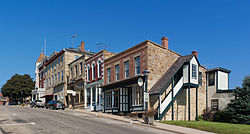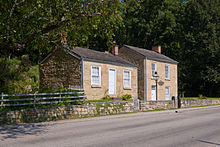- Mineral Point, Wisconsin
-
Mineral Point, Wisconsin — City — High Street, Mineral Point Location of Mineral Point, Wisconsin Coordinates: 42°51′37″N 90°10′59″W / 42.86028°N 90.18306°WCoordinates: 42°51′37″N 90°10′59″W / 42.86028°N 90.18306°W Country United States State Wisconsin County Iowa Settled 1827 Government – Mayor Greggory Bennett Area – Total 3.0 sq mi (7.8 km2) – Land 3.0 sq mi (7.8 km2) – Water 0.0 sq mi (0.0 km2) Population (2000) – Total 2,617 – Density 868.1/sq mi (335.7/km2) Time zone Central (CST) (UTC-6) – Summer (DST) CDT (UTC-5) Website www.mineralpoint.com Mineral Point is a city in Iowa County, Wisconsin, United States. The population was 2,617 at the 2000 census. In 2008 the city's population had taken a decline and is currently only 2,462, but still the second most populous community in Iowa County. One of Wisconsin's oldest cities, Mineral Point was settled in 1827 and became a lead and zinc mining center during the 19th and early 20th centuries. Today the city's historical character has made it a regional tourist destination. The city is located within the Town of Mineral Point.
Mineral Point is part of the Madison Metropolitan Statistical Area.
Contents
History
The first European settlement at Mineral Point began in 1827. During the following year, large quantities of galena, or lead ore, were discovered around the settlement in shallow deposits. Lead had many uses at the time, and settlers began to flock to the region hoping to make a living by extracting the easily accessible mineral. Lead deposits extended throughout an area that also included Dubuque, Iowa and Galena, Illinois, but Mineral Point became the center of lead mining operations within the bounds of present day Wisconsin (then part of Michigan Territory). By 1829, the region's growing population led to the creation of Iowa County, which included all of the lead mining lands within the borders of Michigan Territory at the time. Mineral Point was established as the county seat later that year. The young settlement's importance was further confirmed in 1834 when it was selected as the site of one of two federal land offices responsible for distributing public land to settlers within the area that now encompasses Wisconsin.
When Wisconsin Territory was created in 1836, Mineral Point hosted the inauguration of the first territorial governor, Henry Dodge, and the territorial secretary, John S. Horner. During the ceremony, a design by Horner was officially recognized as the Great Seal of Wisconsin Territory. The seal displayed an arm holding a pickaxe over a pile of lead ore, demonstrating the importance of Mineral Point's early mining economy to the new territory. A census conducted in the months after the inauguration showed that Iowa County had 5,234 inhabitants, making it the most populous county in the Wisconsin Territory east of the Mississippi River.[1]
Mineral Point remained an important lead mining center during the 1840s. Although the most easily accessible lead deposits on the surface were being exhausted by this time, new immigrants began to arrive with more refined techniques for extracting ore. The largest group came from Cornwall, which had been a mining center for centuries. Experienced Cornish miners were attracted to the lead mining opportunities in Mineral Point, and by 1845 roughly half of the town's population had Cornish ancestry.[2] The original dwellings of some of these early Cornish immigrants have been restored at the Pendarvis Historic Site in Mineral Point. Lead continued to be produced in abundant quantities by the Cornish miners, and in 1847, the Mineral Point Tribune reported that the town's furnaces were producing 43,800 pounds (19,900 kg) of lead each day.[3]
Mining activity in Mineral Point began to decline in the following years. In 1848, the same year that Wisconsin achieved statehood, gold was discovered in California. Many experienced miners left Mineral Point to look for gold, and in all, the town lost 700 people during the California Gold Rush.[4] While the lead industry in Mineral Point continued into the 1860s, the town never recovered its former importance. A further blow was struck in 1861 when the county seat of Iowa County was relocated to nearby Dodgeville, Wisconsin, where it remains today. Afterwards there was an intense rivalry between the two cities, during which[when?] Mineral Point fired a cannon towards Dodgeville's direction.[citation needed]
As lead mining declined in Mineral Point, zinc mining and smelting became important new industries. Zinc ore was discovered with increasing frequency near the bottoms of old lead mines. The Mineral Point Zinc Company was founded in 1882, and by 1891 it was operating the largest zinc oxide works in the United States at Mineral Point.[5] Zinc mining and processing continued on a large scale until the 1920s.
Geography
Mineral Point is located at 42°51′37″N 90°10′59″W / 42.86028°N 90.18306°W (42.860465, -90.183204).[6]
According to the United States Census Bureau, the city has a total area of 3.0 square miles (7.8 km²), all land.
Demographics
As of the census[7] of 2000, there were 2,617 people, 1,092 households, and 693 families residing in the city. The population density was 868.1 people per square mile (335.7/km²). There were 1,192 housing units at an average density of 395.4 per square mile (152.9/km²). The racial makeup of the city was 99.01% White, 0.19% Black or African American, 0.04% Native American, 0.23% Asian, 0.15% from other races, and 0.38% from two or more races. Hispanic or Latino of any race were 0.42% of the population.
There were 1,092 households of which 29.6% had children under the age of 18 living with them, 51.0% were married couples living together, 8.9% had a female householder with no husband present, and 36.5% were non-families. 30.5% of all households were made up of individuals, and 13.2% had someone living alone who was 65 years of age or older. The average household size was 2.33, and the average family size was 2.91.
In the city the population was spread out with 24.5% under the age of 18, 7.7% from 18 to 24, 28.8% from 25 to 44, 21.2% from 45 to 64, and 17.7% who were 65 years of age or older. The median age was 38 years. For every 100 females there were 90.5 males. For every 100 females age 18 and over, there were 86.2 males.
The median income for a household in the city was $43,182, and the median income for a family was $52,137. Males had a median income of $31,750 versus $23,396 for females. The per capita income for the city was $21,097. About 3.8% of families and 4.9% of the population were below the poverty line, including 1.5% of those under age 18 and 15.6% of those age 65 or over.
Cuisine
Mineral Point claims to serve authentic Cornish food, such as pasties and figgyhobbin.[8] However, the differences between pasties from Cornwall and those from Mineral Point are stark. Cornish author Rich Smith has noted that Mineral Point pasties are served in polystyrene boxes (not bags), are presented with forks (Cornish pasties are eaten with bare hands). Smith also observed that the pasties in Mineral Point are served with chili sauce and are distinctive in taste. Smith wrote: "It wasn't so much the ingredients that were wrong; it was the texture and the taste. It was dry and quite stodgy and I almost regretted declining the chilli sauce - a difficult thing for a Cornishman to admit."[9]
Recreation
The city is home to an endpoint of the Cheese Country Trail.
Sister city
Notable people
- John Catlin, Acting Governor of the Wisconsin Territory
- Samuel Crawford, Wisconsin Supreme Court
- Amasa Cobb, U.S. Representative
- Lee Croft, NFL player
- Bill Dyke, former U.S. vice presidential candidate
- Jack Enzenroth, MLB player
- David William Hutchison, U.S. Air Force Major General
- Mortimer M. Jackson, jurist and diplomat
- Allen Ludden, host of the game show, Password, was born in Mineral Point.
- James G. Monahan, U.S. Representative
- Daniel B. Moore, Medal of Honor recipient
- Ernie Ovitz, baseball player
- William Thomas Rawleigh, Illinois State Representative
- William Rudolph Smith, Pennsylvania State Senator, Attorney General of Wisconsin
- Cadwallader C. Washburn, U.S. Representative, founder of General Mills
- Alexander Wilson, Attorney General of Wisconsin
Historical buildings
Practically the entire city is a historical district, with block after block of charming stone cottages and businesses crafted by the Cornish settlers in the 1800s. A more recent building is the City Hall, built in 1914, which includes the Library and the Opera House. The Opera House underwent a $2 million renovation in 2010.
Pendarvis is a historically accurate preservation of some of the original cottages, and is a state historical site, open for tours in the summer months. Shake Rag Alley contains seven historic structures, and is a community owned center for the arts, with a robust children's art program, adult classes, and an outdoor summer theatre - Alley Stage.
- Fort Jackson
- Walker House
- Orchard Lawn - home of the Mineral Point Historical Society
- Mineral Point Opera House
- Shake Rag Alley Center for the Arts
Notes
- ^ Thwaites 1895, p.249.
- ^ Nesbit 1989, p.114.
- ^ Fiedler 1973, p.84.
- ^ Fiedler 1973, p.95.
- ^ Fiedler 1973, p.147.
- ^ "US Gazetteer files: 2010, 2000, and 1990". United States Census Bureau. 2011-02-12. http://www.census.gov/geo/www/gazetteer/gazette.html. Retrieved 2011-04-23.
- ^ "American FactFinder". United States Census Bureau. http://factfinder.census.gov. Retrieved 2008-01-31.
- ^ "Pendarvis - Shops & Restaurants"
- ^ Smith, Rich (2006). You Can Get Arrested For That. Corgi. ISBN 9780552154062.
References
- Fiedler, George (1973). Mineral Point: A History. Madison, Wisconsin: State Historical Society of Wisconsin. OCLC 2932430.
- Nesbit, Robert C. (1989). Wisconsin: A History. Madison, Wisconsin: University of Wisconsin Press. ISBN 0-299-10804-X.
- Thwaites, Reuben Gold (1895). "The Territorial Census of 1836". Wisconsin Historical Collections. XIII. Madison, Wisconsin: State Historical Society of Wisconsin. http://content.wisconsinhistory.org/u?/whc,5850
External links
Municipalities and communities of Iowa County, Wisconsin Cities Dodgeville | Mineral Point
Villages Arena | Avoca | Barneveld | Blanchardville‡ | Cobb | Highland | Hollandale | Linden | Livingston‡ | Montfort‡ | Muscoda‡ | Rewey | Ridgeway
Towns CDP Edmund
Unincorporated
communitiesGhost town Pendarvis
Footnotes ‡This populated place also has portions in an adjacent county or counties
Categories:- Cities in Wisconsin
- Populated places in Iowa County, Wisconsin
- 1827 establishments in the United States
- Populated places established in 1827
Wikimedia Foundation. 2010.




